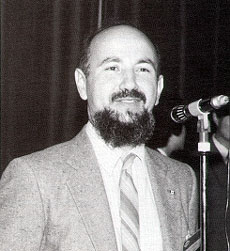 Born,
Esfahan, Iran, 1949, Amir Etemadi, left, graduated, 1971, as an electrical
engineer, Purdue University, and received his M.B.A., Loyola University,
1973, before immigrating to Canada, 1980, settling in Vancouver. Initially
building or renovating a series of funeral homes, car dealerships, and
custom homes in the Vancouver area, Amir discovered that his real niche
was building ski resort accessories, such as lodges, villages, condominiums,
town houses, and restaurants for ski resort sites at both Whistler and
Blackcomb Mountains north of Vancouver. When Amir’s company, Amako, founded,
1983, built the 52,000 square foot Roundhouse Lodge Alpine, capacity, 1,750
patrons, atop Mount Whistler, it superceded another of Amir’s creations,
the 30,000 square foot Glacier Creek Restaurant, a top Mt. Blackcomb, as
the world’s largest mountain-top restaurant. Amako has recently expanded
beyond British Columbia’s acclaimed ski resorts, and currently is building
a 327,000 square foot pedestrian village at Copper Mountain, Denver, Colorado.
Amir’s company is also completing a condominium-hotel at Utah’s Solitude
Mountain and is about to begin still another pedestrian village, this time
at California’s Squaw Valley. No question that Amir Etemadi’s impact in
the ski resort world offers ski buffs, worldwide, state-of-the art winter
resort facilities unexcelled anywhere in the world. [Photo, courtesy Amir
Etemadi]
Born,
Esfahan, Iran, 1949, Amir Etemadi, left, graduated, 1971, as an electrical
engineer, Purdue University, and received his M.B.A., Loyola University,
1973, before immigrating to Canada, 1980, settling in Vancouver. Initially
building or renovating a series of funeral homes, car dealerships, and
custom homes in the Vancouver area, Amir discovered that his real niche
was building ski resort accessories, such as lodges, villages, condominiums,
town houses, and restaurants for ski resort sites at both Whistler and
Blackcomb Mountains north of Vancouver. When Amir’s company, Amako, founded,
1983, built the 52,000 square foot Roundhouse Lodge Alpine, capacity, 1,750
patrons, atop Mount Whistler, it superceded another of Amir’s creations,
the 30,000 square foot Glacier Creek Restaurant, a top Mt. Blackcomb, as
the world’s largest mountain-top restaurant. Amako has recently expanded
beyond British Columbia’s acclaimed ski resorts, and currently is building
a 327,000 square foot pedestrian village at Copper Mountain, Denver, Colorado.
Amir’s company is also completing a condominium-hotel at Utah’s Solitude
Mountain and is about to begin still another pedestrian village, this time
at California’s Squaw Valley. No question that Amir Etemadi’s impact in
the ski resort world offers ski buffs, worldwide, state-of-the art winter
resort facilities unexcelled anywhere in the world. [Photo, courtesy Amir
Etemadi] Behrouz
Tabarrok, right, was born in Tehran, Iran, 1939. His childhood years were
spent playing by the Caspian Sea and wandering the great bazaars of the
city of his birth. Sent to boarding school in England at age 13 years,
Bez thrived in his new-found culture and married a British girl, Carolyn,
1963. After he earned his D. Philosophy from Oxford University, 1965, he
and Carolyn immigrated to Canada where he was made Assistant Professor,
Mechanical Engineering, University of Toronto. An exceptional teacher,
scholar, and consultant, in 1977, Bez was made a full Professor. After
another decade at University of Toronto, he was appointed Founding Chair,
Department of Mechanical Engineering, University of Victoria, British Columbia.
In addition to being an esteemed teacher, scholar of renown, and a distinguished
researcher, Dr. Tabarrok chaired and organized many international symposia,
congresses and conferences. He also served as President, Canadian Society
for Mechanical Engineering. Before he died undergoing a heart by-pass operation,
April 1999, Dr. Tabarrok was made Director, Institute for Integrated Energy
Systems, University of Victoria. The Institute has been a pioneer in the
creation of “fuel cells,” the key component in what may be a technological
and social revolution – the transformation of an oil-based economy to one
based on hydrogen. During his life, Dr. Tabarrok wrote some 250 articles
for a series of international journals and conferences. He received numerous
awards including the Proctor & Gamble Award of Merit, the Robert W.
Angus Medal and the CSME Best Paper Award. Post humously, Dr. Tabarrok
received from McMaster University the annual CANCAM Award, 1999. He leaves
behind his wife, three children, and a grandson. In this view, Dr. Bez
Tabarrok addresses an international symposium, Shanghai, 1987. [Photo,
courtesy Carolyn Tabarrok]
Behrouz
Tabarrok, right, was born in Tehran, Iran, 1939. His childhood years were
spent playing by the Caspian Sea and wandering the great bazaars of the
city of his birth. Sent to boarding school in England at age 13 years,
Bez thrived in his new-found culture and married a British girl, Carolyn,
1963. After he earned his D. Philosophy from Oxford University, 1965, he
and Carolyn immigrated to Canada where he was made Assistant Professor,
Mechanical Engineering, University of Toronto. An exceptional teacher,
scholar, and consultant, in 1977, Bez was made a full Professor. After
another decade at University of Toronto, he was appointed Founding Chair,
Department of Mechanical Engineering, University of Victoria, British Columbia.
In addition to being an esteemed teacher, scholar of renown, and a distinguished
researcher, Dr. Tabarrok chaired and organized many international symposia,
congresses and conferences. He also served as President, Canadian Society
for Mechanical Engineering. Before he died undergoing a heart by-pass operation,
April 1999, Dr. Tabarrok was made Director, Institute for Integrated Energy
Systems, University of Victoria. The Institute has been a pioneer in the
creation of “fuel cells,” the key component in what may be a technological
and social revolution – the transformation of an oil-based economy to one
based on hydrogen. During his life, Dr. Tabarrok wrote some 250 articles
for a series of international journals and conferences. He received numerous
awards including the Proctor & Gamble Award of Merit, the Robert W.
Angus Medal and the CSME Best Paper Award. Post humously, Dr. Tabarrok
received from McMaster University the annual CANCAM Award, 1999. He leaves
behind his wife, three children, and a grandson. In this view, Dr. Bez
Tabarrok addresses an international symposium, Shanghai, 1987. [Photo,
courtesy Carolyn Tabarrok]